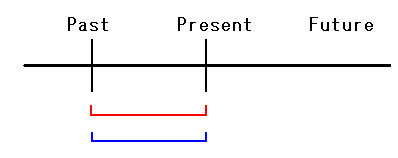EnglishCafe
| previous page | EnglishCafe Top | following page |
 |
5.3.1. The present perfect progressive form The present perfect form (PrPF) which is explained in the chapter 3, the time sense in the past 2, has Perfective and Resultative, Continuous, Experiential as the usage. The present perfect progressive form (PrPPro) has only one, this is continuous. That is to say, the form is different between PrPF and PrPPro, but the usage is the same. (22) I have studied English very hard for one year. PrPF referring to the continuous usage usually uses the for phrase or since phrase/clause. But some verbs are not co-occurred with the for phrase etc. "Study" in the above is the action verb. It can be co-occurred because it does not have the completive meaning itself. The stative verbs, which have continuous, can be co-occurred with them.
Now, the action verbs which have the completive meaning can not be co-occurred with them. (23) *I have written a novel for one year. The above is unacceptable. "Write" has completive. And "reach" is the same. When we express continuous with these verbs, we use PrPPro. (24) I have been writing a novel for one year. That is, we have to use the progressive form which gives the duration for the verbs which does not have the durative meaning. Moreover, PrPPro itself has the durative act, although for phrase is taken, it is acceptable as follows. (25) I have been writing a novel. See the following figure of PrPPro. (26)  The red line is the durative act and the blue line is the speaker's feeling. The red line which starts in a certain past extends to the present without the separation.
|
| previous page | EnglishCafe Top | following page |
| Copyright (c) EnglishCafe : Unapproved printing of the text and figure in this site is forbidden. |

